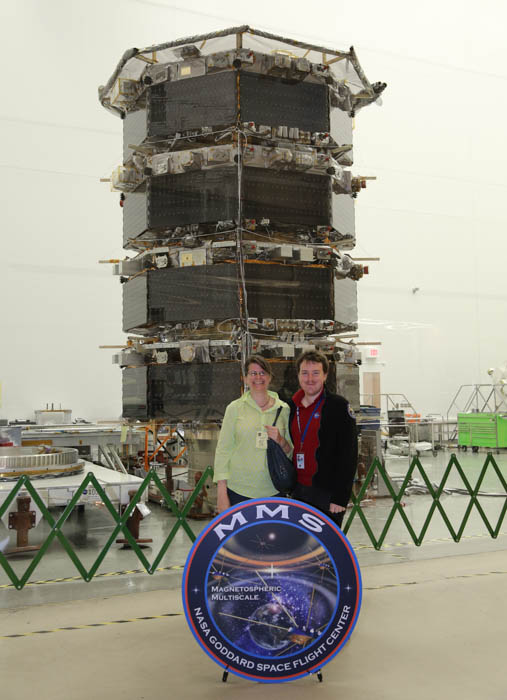On Saturday I went to the visitor’s center at NASA’s Goddard Space Flight Center in Greenbelt, Maryland, showed my driver’s license, and got a yellow paper badge to hang around my neck.
The occasion: the friends and family day for MMS, the Magnetospheric Multiscale Mission.
MMS isn’t one of NASA’s better-known missions. When I googled the acronym to double-check the full name, I had to scroll way down, past M&Ms, a middle school in Texas, and someone selling a cure-all mineral solution.
But, for NASA, MMS is a big deal. They’ve put hundreds of millions of dollars into this mission, which will study the physics where the Earth’s magnetic field and the Sun’s magnetic field meet.
MMS is also a big deal for my boyfriend, who works on it. After a few minutes of looking at MMS-related displays on tables set up in the visitors’ center, we friends and family filed onto a bus past security people who eyed every yellow badge. An Eastern kingbird watched us drive through the gate from atop a tall fence. Glyn narrated as we went. “That’s building 12. You can tell because it has a 12 on it.” (I think he also told me a fact about building 12, but I forgot it.)
As we waited to get off the bus outside the complex of clean rooms, a woman behind us put on an I’m-not-kidding tone to tell a boy: “Listen to me. We are going in amongst spacecraft. You will behave.”
A lot of cool science happens at Goddard, but the buildings themselves aren’t much to look at. Most are brick, a few stories high, set so far apart that people routinely drive to meetings. At first glance, the inside of this one wasn’t any more impressive than the outside. Yellow tape kept us from wandering into long side hallways filled with doors, like any old academic building.
Then we got in amongst the spacecraft. We walked through a long, cavernous, concrete-floored space along a row of small clean rooms, their frames covered in heavy, clear plastic. They were surrounded by mysterious-looking pipes and racks of cardboard boxes.
We turned a corner at what Glyn told me is the “giant tank of space”—for testing things in a very cold vacuum—and came to the huge clean room holding MMS. Goddard’s largest clean room is occupied by the James Webb Space Telescope, but this room was plenty impressive, a kind of alcove with a huge blue crane fixed to the ceiling, several stories up. Bands of heavy plastic film stretched across the entrance to keep gunk from getting in and sticking to the spacecraft.
The MMS mission is actually made up of four separate spacecraft. They’ll fly in formation in the Earth’s magnetosphere, the bubble of space that is affected by our magnetic field. The magnetosphere protects us from the solar wind; without it, we might not be here. When the solar wind hits the magnetosphere, things happen. Magnetic field lines break and reconnect. Particles swirl. The four units of MMS carry dozens of instruments that will measure all the things, in four places at the same time, to get a three-dimensional idea of what’s going on.
Before that can happen, you have to get them into space. And, to do that, you have to put them in a rocket. When a rocket blasts off, things shake. Think of a stack of hat boxes in an earthquake. In April the MMS spacecraft were piled up for testing, to make sure they could withstand the vibration. Here’s the stacking process, condensed into about a minute, shot from the back of the clean room:
Each of the four spacecraft is an octagon covered in solar panels. There’s an instrument or antenna or a thruster in every place where it will fit. Glyn pointed out where his instruments will go. All of that equipment will fit into the launch vehicle with only an inch to spare on each side.
Two shiny plaques on the spaceship were a little too high up to read. We asked a manager who was acting as a tour guide for the day. They’re memorials for two of the hundreds of people who have worked on MMS.
It takes a huge amount of human life and effort to get something like this into space. This weekend, the engineers and scientists and technicians brought their husbands and toddlers and girlfriends and pointed out the wires and gadgets with which they were intimately acquainted. Everyone lined up to pose for photos in front of the clean room.
Sometime next spring, the MMS spacecraft will pile into a massive Atlas V rocket at Cape Canaveral and head out to space. After launch, the spacecraft will pop off, one by one; booms will extend; and science will start.
Photo: NASA

One thought on “Giant Stack of Spacecraft”
Comments are closed.